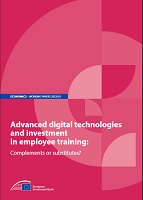EIB Working Paper 2023/01 - Advanced digital technologies and investment in employee training
Complements or substitutes?
| dc.date.accessioned | 2023-10-12T09:58:09Z | |
| dc.date.available | 2023-10-12T09:58:09Z | |
| dc.date.issued | 2023 | |
| dc.identifier | OCN: 1381239528 | |
| dc.identifier.uri | https://library.oapen.org/handle/20.500.12657/76672 | |
| dc.description.abstract | The use of advanced digital technologies such as 3D printing, advanced robotics, drones, big data analytics and artificial intelligence is spreading. These technologies have uncertain implications for labour demand. Affected workers may need to re-train to adapt to changing tasks or new jobs. At the same time, it is unclear whether or not advanced digital technologies encourage firms to invest in workforce re-training. Using firm-level data covering the 27 EU countries, the UK and the US, this paper shows that employers tend to reduce investment in training per employee, after adopting advanced digital technologies. It estimates, with a control function approach, firm-level production functions augmented with two factors: training per employee and digital technology use. We show that these are in fact substitutes in production, implying that an increase in the former negatively affects the marginal productivity of the latter, and that a decline in the cost of introducing advanced digital technologies reduces employers’ investment in training per employee. These findings point to challenges in realising high levels of firm-sponsored training for employees in increasingly digital economies. | en_US |
| dc.language | English | en_US |
| dc.subject.other | Business & Economics; Banks & Banking | en_US |
| dc.title | EIB Working Paper 2023/01 - Advanced digital technologies and investment in employee training | en_US |
| dc.title.alternative | Complements or substitutes? | en_US |
| dc.type | book | |
| oapen.identifier.doi | 10.2867/16937 | en_US |
| oapen.relation.isPublishedBy | 66479d04-7b84-49c0-9a4d-db552a3ecc71 | en_US |
| oapen.relation.isFundedBy | b818ba9d-2dd9-4fd7-a364-7f305aef7ee9 | en_US |
| oapen.collection | Knowledge Unlatched (KU) | en_US |

